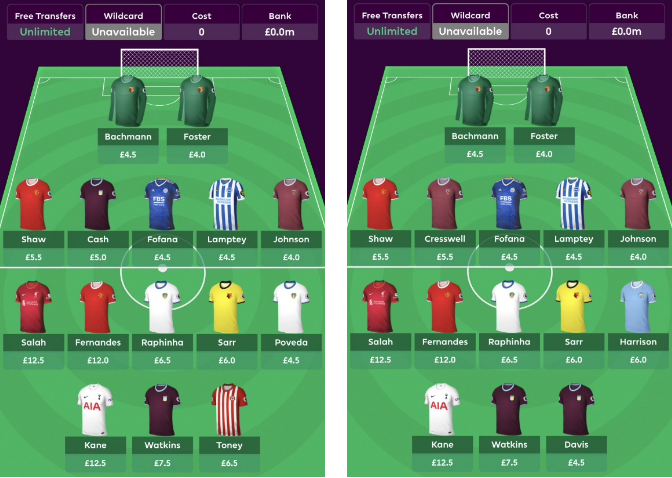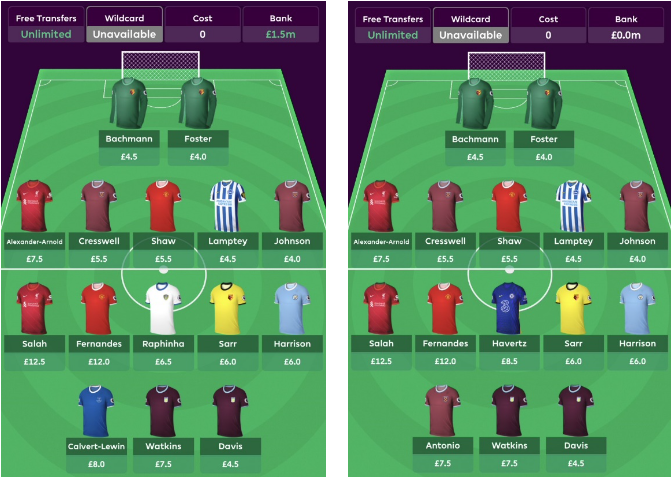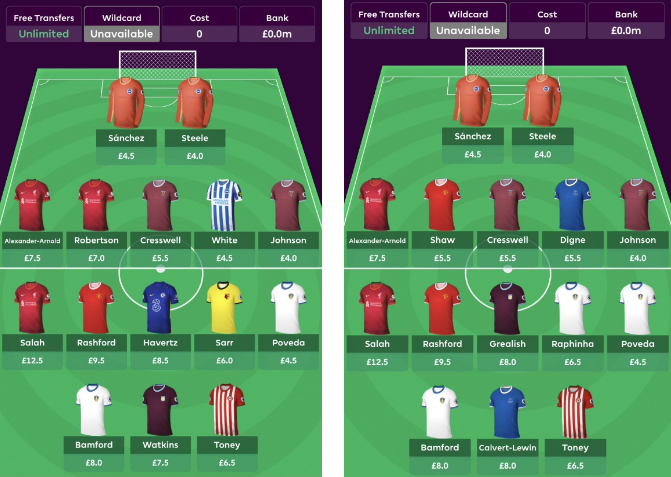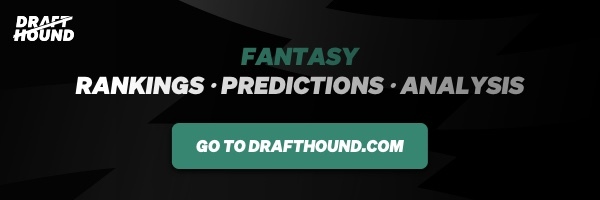As an FPL player, I have always been skeptical of those who talk about team structure as a fundamental aspect of playing FPL. My thought has always been: “pick the best players and whatever structure that creates should be the best structure.” To a degree, this is a fair assessment; you want the best players in your team, and you want a structure that suits those players. However, we rarely know the best assets pre-GW1. While the approach of players first, structure second may work for later wildcards (once we have identified the better assets at each position), this approach is asinine going into GW1. Upon the release of the 21/22 FPL Season, I have analyzed my own team data from last season and have applied ideas of team structure in an attempt to learn how team structure can help us better perform in FPL, especially at the start of the game.
What is Team Structure?
To FPL newcomers, “team structure” is a term you may not be familiar with. Team structure is a way to describe the organization of a team based on prices. With a budget of 100.0 million to start the game, we must selectively pick which of our 15 players are premium assets, which are mid-priced assets, and which are budget or bench assets. In doing so, the various arrangement of assets across a 15- man squad yields many team structures, each with their own pros and cons. In this article, I will breakdown the most feasible team structures going into the 21/22 season, explaining the pros and cons of each structure. Before I do that, I want to back up my earlier claim as to why team structure is a factor of FPL that should not be overlooked, and why a lack of structure can be of detriment to managers.
*As a disclaimer, team structure and formation are not the same. Team structure relates to the price breakdown per position whereas formation relates to the amount of starting players in each position. For each of these structures, I will be approaching the breakdown with a 343 or 352 formation in mind, with a fourth playing defender to rotate to 442 or 451, respectively.*
The Importance of Team Structure for the 21/22 FPL Season
It must be asked, why is team structure so important? Why is it so important if I can just make a few transfers and boom! my team has a new structure? One thing that team structure does is that it allows a manager to narrow their field of view. A struggle that many have in FPL is the abundance of options and a lack of ability to clarify which are better than others. To be fair, this is an extremely complex game, so simplifying our tasks as managers (where possible) is of value to our experience playing the game. As experienced managers will know, it can be easy to get distracted by a certain asset and then try to cram that asset into your squad, even at the cost of multiple transfers. Although it may seem like switching out one asset for another, at times this can be like putting a square peg in a round hole – it just will not work without excessive measures. While we may be enticed by a certain asset, understanding which assets fit your chosen structure will help with these scenarios. While a novice- level FPL player may seek to get that asset into their squad, a more experienced player will understand that their structure does not suit that asset and therefore the asset must be overlooked for the time being. This is one major benefit of team structure, it can help to make us more disciplined as managers and in doing so, simplify aspects of the game.
In my perspective of FPL, there are two modes of currency: actual funds (team value/player prices) and team-altering funds (transfers and chips). These are the two things that allow managers to exercise agency over the game, without these we would be powerless. What this also means is that they are the most important aspects of the game, specifically the latter. Once you have your Gameweek 1 team, you get 37 free transfers, two wildcards, and three chips. That is all you have to alter your team for the nine months of the FPL season!
To achieve success in FPL, we must utilize these so-called “funds” to the best of our ability, this is where team structure comes in. The greatest variable with team structure is how many transfers it takes to transition your structure from Point A to Point B. I will get into this in greater detail later but let’s say a defense consists of these prices: 7.5-5.5-4.5-4.5-4.0. In this given structure, it is easy to transfer the 5.5 slot to a 5.0 or 4.5 million defender, but it would be much more difficult to transfer that 5.5 slot up to a 6.0-7.0 million defender. Understanding the flexibility of your chosen system is a must! If you go in haphazardly and want to exchange your 5.5 m defender for a 6.0 m defender, you will face a scenario of needing to spend two transfers just to make that switch happen. For a more drastic example, imagine attempting to shift one of Salah (12.5) or Bruno (12.0) to Kane (12.5). Due to Kane being a forward, this switch needs at least two transfers, possibly 3 for a (-4) hit. You want to avoid these scenarios as much as possible because it is not an efficient use of transfers. Setting up a team structure and understanding the limits of that structure is necessary to manage your team effectively.
Given that wildcards are the most powerful asset to an FPL manager, as they allow us to restructure and redefine a team completely, we can view the season as three trimesters: original team, wildcard 1 team, and wildcard 2 team. Each of these three moments allows us to establish a new structure for our team. With the following examples, I will look at the first trimester of FPL – initial draft teams. These structures are contextualized by this trimester, as our approach to FPL changes throughout the season.
Possible Team Structures for 21/22 FPL Season
With the basics and more theoretical aspects of team structure explained, let’s apply these ideas to the current assets available in the game. I will present 4 team structures, titled around the cornerstones of that structure, and describe the possible pros and cons of each structure. In each structure, I will create a starting XI plus 1-2 playing bench assets.
Structure 1: Three premiums
The first structure is one that was very popular throughout the 20/21 season but is generally seen as less feasible going into this season, due to the price increase of players like Kane, KDB, and Bruno. There are 5 assets in the game priced at 12.0 m or higher: Kane, KDB, Bruno, Salah, and Mane. These are the premium assets, as we can expect massive points from them throughout the season and their prices reflect that. This team structure allows players to select three of these five assets at the cost of needing budget options elsewhere. The most expensive combination of these five would be: Kane (12.5), Salah (12.5), and one of the other three mids (12.0). For the more gluttonous managers out there, I will interrogate this combination – filling in the other 12 assets with 63.0 m to spend.
Goalkeepers (8.5-9.0 m) – As you are spending so much money elsewhere, you will want to go with either a 4.5/4.0 m goalkeeper combination (Sanchez/Steele, Bachmann/Foster, Krul/Gunn) or a 5.0/4.0 m combination (Schmeichel/Ward for example). The goalkeeper slots are ones that you never want to change, regardless of your team structure; so, pick a cheap option with a nailed goalkeeper for your starter.
Defense (23.0-24.0 m) – You will also need to go for budget options in defense, given the amount spent on your premium assets. To go with this structure, you will have to go without one of the most highly praised assets, Trent Alexander-Arnold. This could be a big risk, given how many people will own him and his FPL history, but you could make up for it with your extra premium asset. The price structure of the defense would be something like: [5.5-4.5-4.5-4.5-4.0], [5.5-5.0-4.5-4.5-4.0], or [5.5- 5.5-4.5-4.5-4.0]. If you believe the 5.5 m defenders such as Shaw, Digne, and Cresswell offer great value and think you can pick the right 4.5 m defenders at the start of the game, this structure may work very well for you.
Midfield (41.0-43.5 m) – The first two midfield slots are taken up by Salah and a 12.0. The final three spots consist of either two 5.5-6.5 mids and a 4.5 bench player or three 5.5-6.5 mids. The final spot is dependent on whether you want your twelfth playing asset to be a midfielder or a forward. This structure favors the likes of Raphinha, Harrison, Buendia, Smith-Rowe, etc. If you see value in these assets, this structure could work well, although it comes at the cost of never being able to get a midfielder like Havertz, Barnes, Grealish, Greenwood, or Foden. As I said earlier, settling on a structure narrows down your focus as a manager; in this case, you can just overlook those mid-priced midfielders because it is too difficult to fit them in without compromising the structure.
Forwards (26.0-27 m) – The first forward in is Kane at 12.5 m. Following Kane would be one forward in the 7.5-8.0 m range and one in the 6.0-6.5 m range. This structure allows for a variety of forwards, but you must be very selective in who fills those latter two spots. There may be a budget forward who emerges in the first few weeks, such as Bamford and Watkins did last season. If that is the case, this formation is well suited to accommodate such assets, although it may take a transfer or two to switch to the right one.
Further Read: An In-Depth Look at Team Structure 1: Three Premium Assets
Possible Teams:

Pros: This structure allows you to make the most of the premium assets. As most people will only have two premium assets, this structure will gain an edge by having three. As the first few weeks of the FPL season roll on, you will be able to downgrade any of the three premiums to an in-form asset, providing you with money in the bank to upgrade elsewhere. This structure can be very flexible, but only if the plan is to sell the worst performing premium asset and reallocate those funds after a few weeks’ time.
Cons: First, you are missing out on both Trent and Robertson with this structure, whom many players will have. Second, this structure rests on the assumption that the low-priced players (4.5 defenders, 6.0 mids, 6.5 fwds) will outperform their price and you will be able to pick the right assets in the first few weeks. In the scenario that a mid-priced defender or midfielder (5.5-6.5 def or 7.0-9.5 mid) starts the season with a bang, you will have difficulty bringing that player in without compromising one of the premium assets.
Further Read: An In-Depth Look at Team Structure 1: Three Premium Assets

Structure 2: Two premium mids
The second structure replaces Kane in the previous structure and reallocates those funds elsewhere. This is one of the two most popular structures, as it is the most balanced generally. There is an even spread of premium assets, mid-priced assets, and budget assets. While this balance is enjoyable and allows for a lot of tinkering, it makes things complicated as an FPL manager because there are so many possibilities. It is difficult to summarize the vast combinations for this structure, but let’s look at some options in each position.
Goalkeepers (8.5-9.5 m) – The goalkeeper slots should still be kept to a minimum price, although this structure allows you to go for two playing 4.5 keepers or a 5.5 and a 4.0, if you so desire. Generally, the best approach to keepers is to find the best value 4.5 and stick, and this structure should be no different.
Defenders (27.0-28.5 m) – This structure allows Trent to fit in the team very easily. He should probably be the first name in everyone’s defense, so long as your structure permits it. Following Trent, this structure allows for a range of defensive options. [7.0, 5.5, 4.5, 4.0], [5.5, 5.5, 4.5, 4.0], and [5.5, 4.5, 4.5, 4.0] are all valid options for the remaining four spots.
Midfielders (41.5-44.5 m) – Following Salah and a 12.0, this structure allows for a range of midfield options (sensing a theme?). [8.0, 6.0, 4.5], [6.5, 6.0, 6.0], and [6.5, 6.0, 4.5] are all viable options. If you are going with a pricier back line, the latter two options will be more viable whereas a budget back line can afford some pricier midfielders.
Forwards (21.0-23.0 m) – Given that most of the funds are being shifted from Kane to the defense and midfield, the forward options do not change much aside from replacing Kane. This structure can allow for Kane to be shifted down anywhere from Werner at 9.0 to Wood at 7.0 to a bench player at 4.5. This really depends on where you want to allocate those extra funds, who you see as the most valuable for their price, and what formation you want to play.
Further Read: An in-depth look at two premium midfielders
Possible Teams:

After downgrading Kane to DCL and upgrading a 4.5 def to Trent, there is 1.5 m left in the bank to play around with. If you wanted to scrape it down to the bare bones of this structure, downgrading Cresswell/Shaw to a 4.5 m def and DCL down to Antonio would leave 3.0 m in the bank. How I see this is that the extra 1.5-3.0 m leftover is for you to express yourself as an FPL manager. If you like Havertz as an option (see second picture), you can upgrade to him; if you like Robertson, you can upgrade to him. That extra money is where all the tinkering can be done once you’ve established the bones of this structure.
Pros: This structure is the most typical at this moment in time, so it will allow you to stick with the pack at the beginning of the season. As noted before, this structure also allows you to express yourself as an FPL manager, upgrading to your favorite mid-priced assets. This structure has a nice balance of assets at all price points, so theoretically picking the best option at each of those price points would yield a very successful team. In the beginning of the season, if your 6.0 m mid or 7.5 m fwd is not performing, you can easily shift them to a similar asset.
Cons: There is so much tinkering to be done with this structure, although you can make it more stringent if you’d like. Adding Robertson into the defense alongside Trent, for example, would stretch the budget elsewhere. As well, there is very little flexibility in switching Salah or the 12.0 m mid to Kane. Although they are all premiums, it costs at least two transfers to make that switch happen. If you go with this structure, you should imagine that Kane does not exist until your first wildcard.
Further Read: An in-depth look at two premium midfielders

Structure 3: One premium mid, one premium forward
For the sake of brevity, I will not give a detailed breakdown of the positions as it is very similar to Structure 2. The main difference is that the 12.0 m mid is swapped for Harry Kane (12.5 m) up top. The reason why these two structures are differentiated is that although they are similar, you cannot switch back and forth between them. Given the nature of positions, it requires at least two transfers to switch a 12.0 m mid to Kane, which is unreasonable for an efficient FPL manager. The pros and cons are similar to Structure 2, it is just that Kane is in the team instead of Bruno, KDB, or Mane.
Possible Teams:

The main liberty that this structure affords is a pick between the plethora of mid-priced midfielders. The other structures do not favor assets such as Jota, Havertz, Greenwood, Mahrez, etc. If any of those assets begins to shine, this structure will allow you to get them fairly easily, although it may still cost two transfers.
Further Read: An in-depth look at one premium midfielder and Forward Structure
Structure 4: One premium/Big at the back
While the previous three structures are the most popular, it must be asked: what if you only went with one premium player? Given the prospects of Kane, Bruno, KDB, and Mane it is not at all unreasonable to only go with Salah (going without Salah is crazy imo). The other big question regards the big signing of the summer so far, Jadon Sancho; this structure is most adaptable to fit Sancho into your team (assuming he is priced at 9.5-10 m).
Goalkeepers (8.5-9.5 m) – Same concept as before applies.
Defenders (27.0-28.5 m) – This structure is the same as 2/3, although it allows both Trent and Robertson to get into the team easily. “Following Trent, this structure allows for a range of defensive options. [7.0, 5.5, 4.5, 4.0], [5.5, 5.5, 4.5, 4.0], and [5.5, 4.5, 4.5, 4.0] are all valid options for the remaining four spots.”
Midfielders (39.5 m-43.0 m) – This structure allows the midfield to be flexible and fluid, allowing players to shift between various mid-priced options. The likes of Sancho, Rashford, Mahrez, Foden, Grealish, Greenwood, etc. are the players this structure is best suited to target.
Forwards (21.0 m-23.5m) – This structure favors the mid-priced forwards, namely Cavani, Bamford, DCL, Watkins, Iheanacho, Antonio, Toney, and Welbeck. You can easily fit three of these forwards in with little detriment to the rest of the squad. The biggest issue is finding the best value pick or switching from one to the other at the right time.
Possible teams:

Conclusion, Thoughts for 21/22 FPL Season
In conclusion, there are many structures your FPL team can take the form of. Hopefully, this guide helped to offer various options and shed light on the positives and negatives of each one. The most important takeaway is to understand that team structure is important because it limits team flexibility until the use of Wildcard 1. You must conscientiously know which structure your team falls under and conduct your transfers given those constraints. Structure 1 targets budget options and attempting to hit early price rises, with the opportunity to downgrade a premium asset if need be. Structures 2 and 3 target a combination of mid-priced and budget assets but do not allow any fluidity between premium options. Structure 4 targets the higher mid-priced options and allows a big at the back structure. I hope this helps, good luck picking your 21/22 FPL teams!

Don’t want to pay and try out a free trial instead?
Get a seven-day free trial for FFHUB now: Free trial
2021/22 FPL Season ALLABOUTFPL Mini League:
AllAboutFPL League (smfms7): Autojoin link
Thanks for reading the 21/22 FPL season strategy blog. Keep checking allaboutfpl.com for regular blogs. Also, follow our 19000+community on Instagram, Facebook, and Twitter to stay updated on regular Posts and FPL updates. Link to all our 2021/22 FPL pre-season blogs.
Further Reads from ALLABOUTFPL Ahead of the 2021/22 Season:

What’s next from ALLABOUTFPL ahead of the 2021/22 FPL Season?
We’ll be covering the lengths and breaths of FPL covering and analyzing every single topic possible right from team previews, fixture analysis, position analysis, tips, and strategy from our expert writers over the pre-season. Keep checking allaboutfpl.com for all our blogs and subscribe to our free newsletter through the link below. We’ll also be posting regularly about the same on our social media accounts so follow us on Twitter, Instagram, and Facebook keep our notification ON.
Our content is always free and if you like our content do drop a comment, follow, subscribe, and support us. Your love is what keeps us going:)

FPL GW1 FPL Deadline Countdown
Login and set your team for FPL GW1 now!
Alex Michel
Latest posts by Alex Michel (see all)
- FPL DGW37 Man City Preview | Player-Wise Analysis & Thoughts - May 18, 2023
- How to Approach Man City FPL Assets for FPL GW33-38 - April 24, 2023
- UCL Fantasy Tips & Players to Target- Matchday 7 - February 14, 2023




